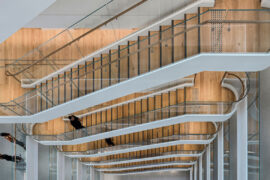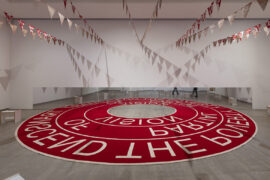Insights from Hassell’s 2021 Workplace Futures Survey could add fidelity to the design brief, revealing the motives underlying what employees envision for the hybrid workplace.

According to the internet, Henry Ford once said: “if I asked people what they wanted, they would have said faster horses.” The quote’s attribution to the 19-century industrialist is dubious, but the gist of it holds true — and it’s a point that is evidently not lost on Hassell, based on the punchy annual workplace report the prominent global design practice has released for 2021. The Evolving Office: 2021 Workplace Futures Survey cuts through the monotony of familiar findings pertaining to the future of work and presents fresh insights, perceptive of not ‘what’ employee preferences are dominant, but ‘why’.

Commercial (Large): Arup Melbourne Workplace by HASSELL in Partnership with Arup
“We have a tendency to assume that the future will simply be an extension of the present. So before the pandemic, when we were working from the office, the idea of ongoing working from home seemed impossible. And during the pandemic, when we were working from home, the idea of everyone going back to the office also seemed absurd,” reads an extract from The Evolving Office: 2021 Workplace Futures Survey report. This aptly captures the scene of the present predicament faced by workplace designers, strategists and executives alike.
For 12 months now, we’ve been inundated with reports and research into ‘the future of work’, that all seem to land on the following, as a matter of consensus. Ongoing flexible working arrangements; decentralised operations; evolution of the hybrid workplace typology; and offices geared to facilitate collaboration, employee engagement and activity-based work are said to be the foundations for the future of work.
“At Hassell, we didn’t want to just imagine what employees would be looking for, we wanted to better understand their preferences,” reads Hassell’s report. “We were particularly interested in learning where people wanted to work after the pandemic, what was driving their preferences, and understanding what office buildings could do to entice people back.”
Informed by 2,300 office workers, hailing from Australia, Singapore, the UK and the USA, Hassell’s longitudinal survey sought to dig deeper into the existing insights—e.g. employees do not want to return to the office full time—and to strength test their truth. What it uncovered was that by reframing the typical survey question from “How many days per week would you like to work at home?” to the format of a preference test, in which participants were asked to select their preferences between different workplace scenarios, produced vastly different results, with people tending to pick scenarios that have them come into the office more regularly.

“The main factors influencing people’s preferred workplace model were a person’s age and their mode of transport to work. Young people were far more likely to prefer hybrid workplace models compared to older employees,” cites the report. “People that drove to work were far more likely to want to return to the office full-time when compared to people that took public transportation. For companies looking to adopt a new workplace model, these results show how the workplace model can be tuned to target particular goals, such as retention and talent attraction.”
Workplace amenities have become a hot topic amidst the flurry of speculation about what the future of work holds in store for us. Much of this is driven by the developers and owners of commercial properties seeking to understand how they might entice workers back to working in the office more permanently. As a part of Hassell’s 2021 Workplace Futures Survey, participants were presented with a long list of features, ranging from doggy daycare to more greenspace, and asked to pick their top five. One of the most striking features of these results is that a lot of the high-end, nice-to-have amenities were the least popular.

“We tend to think of things like on-site childcare, a personal concierge and makers spaces as being incredible workplace perks – and they are – but they’re not things that people generally prioritise. This is possibly because things like on-site childcare only appeal to narrow demographic groups,” cites the report.
The two most wanted perks were free lunch and a shorter commute. Right behind them were a whole host of practical considerations, with people selecting options like more space to focus, more space to collaborate, and better meeting facilities.
This research suggests that more than anything, companies should be ensuring that they’re getting the basics right, and that they’re providing the right space for work to occur. Only after this is taken care of, should all the extras be added on.
Read The Evolving Office: 2021 Workplace Futures Survey, presented by Hassell, here.
For more Indesign insights into the future of work, click here.
INDESIGN is on instagram
Follow @indesignlive
A searchable and comprehensive guide for specifying leading products and their suppliers
Keep up to date with the latest and greatest from our industry BFF's!

Welcomed to the Australian design scene in 2024, Kokuyo is set to redefine collaboration, bringing its unique blend of colour and function to individuals and corporations, designed to be used Any Way!

A curated exhibition in Frederiksstaden captures the spirit of Australian design

The undeniable thread connecting Herman Miller and Knoll’s design legacies across the decades now finds its profound physical embodiment at MillerKnoll’s new Design Yard Archives.

For Aidan Mawhinney, the secret ingredient to Living Edge’s success “comes down to people, product and place.” As the brand celebrates a significant 25-year milestone, it’s that commitment to authentic, sustainable design – and the people behind it all – that continues to anchor its legacy.

Emily Moss, Brooke Lloyd, Juliette Arent Squadrito and Alexandra Ramundi joined Alice Blackwood at Living Edge’s stunning showroom to discuss a milestone approach to design.

Brad Krauskopf, CEO & Founder of Hub Australia, tells us about Hassell’s design for Hub Australia Martin Place.
The internet never sleeps! Here's the stuff you might have missed

Melbourne is the destination and Saturday 6th September is the date – get ready for this year’s one-day design extravaganza with a full guide to what’s on.

‘Breathing Helps’ is a major solo exhibition bringing together Nolan’s large-scale works with new commissions and performances.